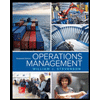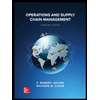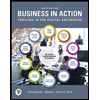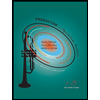
Practical Management Science
6th Edition
ISBN: 9781337406659
Author: WINSTON, Wayne L.
Publisher: Cengage,
expand_more
expand_more
format_list_bulleted
Concept explainers
Question
Customers arrive to a local bakery with an average time between arrivals of
5 minutes. However, there is quite a lot of variability in the customers’ arrivals, as
one would expect in an unscheduled system. The single bakery server requires an
amount of time having the exponential distribution with mean 4.5 minutes to serve
customers (in the order in which they arrive). No customers leave without service.
b. Calculate how long customers spend on average to complete their transactions
at the bakery (time in queue plus service time). What percentage of that time is
spent queueing?
Expert Solution
This question has been solved!
Explore an expertly crafted, step-by-step solution for a thorough understanding of key concepts.
This is a popular solution
Trending nowThis is a popular solution!
Step by stepSolved in 2 steps with 2 images

Knowledge Booster
Learn more about
Need a deep-dive on the concept behind this application? Look no further. Learn more about this topic, operations-management and related others by exploring similar questions and additional content below.Similar questions
- 5. The DMV Licensing office has a single line for customers waiting for the next available clerk. There are two clerks who work at the same rate. On average customers arrive every 8 minutes and the average service rate is 5 per hour for each of the two clerks. The arrival rate of customers follows a Poisson distribution, while the service time follows an exponential distribution. d.) Because the state has received less than expected tax receipts, the DMV is thinking of cutting one position. Is this a good idea? Why?arrow_forward1. The DMV Licensing office has a single line for customers waiting for the next available clerk. There are two clerks who work at the same rate. On average customers arrive every 8 minutes and the average service rate is 5 per hour for each of the two clerks. The arrival rate of customers follows a Poisson distribution, while the service time follows an exponential distribution. a.) What is the service rate? (please include units) b.) What is the arrival rate? (please include units)arrow_forwardGive and explain briefly that in what kinds of situations is queuing analysis is most appropriate.arrow_forward
- Please do not give solution in image format thanku Average Arrival Rate (Ri) 20 Customers/Hr Arrival Standard Deviation is 2 customers/hr Average Processing Time 12 minutes Process Time Standard Deviation 3 minutes 5 Servers 1) What is Server Utilization? 2) Average Queue Length?arrow_forwardWhat is the answer in this number 3?arrow_forwardMom and Pop own and operate the Fuzzy Belly Deli. On average, customers arrive at the deli every 6 minutes. Pop fulfills their orders one at a time. It takes him an average of 3 minutes to fulfill each order. Customers then proceed to the cash register, where Mom receives their payment. Mom loves to chat and is somewhat slow in operating the cash register, taking an average of 4 minutes to receive payment from each customer. Assume that customer interarrival times, as well as order fulfillment and payment times are exponentially distributed. What is the throughput of the deli's operation? What is the capacity of the deli's operation? On average, how long does a customer spend at the deli from the time she arrives until her order is fulfilled by Pop?arrow_forward
- The office has a single line for customers waiting for the next available clerk. There are two clerks who work at the same rate. On average customers arrive every 8 minutes and the average service rate is 5 per hour for each of the two clerks. The arrival rate of customers follows a Poisson distribution, while the service time follows an exponential distribution. b.) What proportion of time are both clerks idle? c.) Counting each person being served and the people in line, on average, how many customers would be in this system?arrow_forward4.) The DMV Licensing office has a single line for customers waiting for the next available clerk. There are two clerks who work at the same rate. On average customers arrive every 8 minutes and the average service rate is 5 per hour for each of the two clerks. The arrival rate of customers follows a Poisson distribution, while the service time follows an exponential distribution. a.) What percentage of the total available service time is being used? b.) Due to Covid restrictions, only two customers are allowed in the office at the same time. What percent of the time will there be customers waiting outside?arrow_forwardPLS HELP!!!arrow_forward
- How does an event improve the smooth queue management?arrow_forward3 The M/M/1 Queue During peak time, customers arrive at a bank teller window (with a single teller) at a rate of 23 per hour, where the teller can serve 25 per hour. This problem will allow you to investigate (via a simple extension of the mean queue size formula) the effect of highly-variable service times on our familiar queuing metrics. The diagram below stylizes the queuing system: Waiting Service Calculate the marginal probability P (T > oT). a. O b. 0.25 O c. 0.63 O d. 0.75 Calculate the mean time a customer spends at the bank (waiting time plus service time) in minutes. O a. 30 minutes O b. 27.6 minutes O c. 2.4 minutes O d. 7 minutesarrow_forwardplease dont answer in image format. Do type Thnksarrow_forward
arrow_back_ios
arrow_forward_ios
Recommended textbooks for you
 Practical Management ScienceOperations ManagementISBN:9781337406659Author:WINSTON, Wayne L.Publisher:Cengage,
Practical Management ScienceOperations ManagementISBN:9781337406659Author:WINSTON, Wayne L.Publisher:Cengage, Operations ManagementOperations ManagementISBN:9781259667473Author:William J StevensonPublisher:McGraw-Hill Education
Operations ManagementOperations ManagementISBN:9781259667473Author:William J StevensonPublisher:McGraw-Hill Education Operations and Supply Chain Management (Mcgraw-hi...Operations ManagementISBN:9781259666100Author:F. Robert Jacobs, Richard B ChasePublisher:McGraw-Hill Education
Operations and Supply Chain Management (Mcgraw-hi...Operations ManagementISBN:9781259666100Author:F. Robert Jacobs, Richard B ChasePublisher:McGraw-Hill Education
 Purchasing and Supply Chain ManagementOperations ManagementISBN:9781285869681Author:Robert M. Monczka, Robert B. Handfield, Larry C. Giunipero, James L. PattersonPublisher:Cengage Learning
Purchasing and Supply Chain ManagementOperations ManagementISBN:9781285869681Author:Robert M. Monczka, Robert B. Handfield, Larry C. Giunipero, James L. PattersonPublisher:Cengage Learning Production and Operations Analysis, Seventh Editi...Operations ManagementISBN:9781478623069Author:Steven Nahmias, Tava Lennon OlsenPublisher:Waveland Press, Inc.
Production and Operations Analysis, Seventh Editi...Operations ManagementISBN:9781478623069Author:Steven Nahmias, Tava Lennon OlsenPublisher:Waveland Press, Inc.

Practical Management Science
Operations Management
ISBN:9781337406659
Author:WINSTON, Wayne L.
Publisher:Cengage,

Operations Management
Operations Management
ISBN:9781259667473
Author:William J Stevenson
Publisher:McGraw-Hill Education

Operations and Supply Chain Management (Mcgraw-hi...
Operations Management
ISBN:9781259666100
Author:F. Robert Jacobs, Richard B Chase
Publisher:McGraw-Hill Education


Purchasing and Supply Chain Management
Operations Management
ISBN:9781285869681
Author:Robert M. Monczka, Robert B. Handfield, Larry C. Giunipero, James L. Patterson
Publisher:Cengage Learning

Production and Operations Analysis, Seventh Editi...
Operations Management
ISBN:9781478623069
Author:Steven Nahmias, Tava Lennon Olsen
Publisher:Waveland Press, Inc.